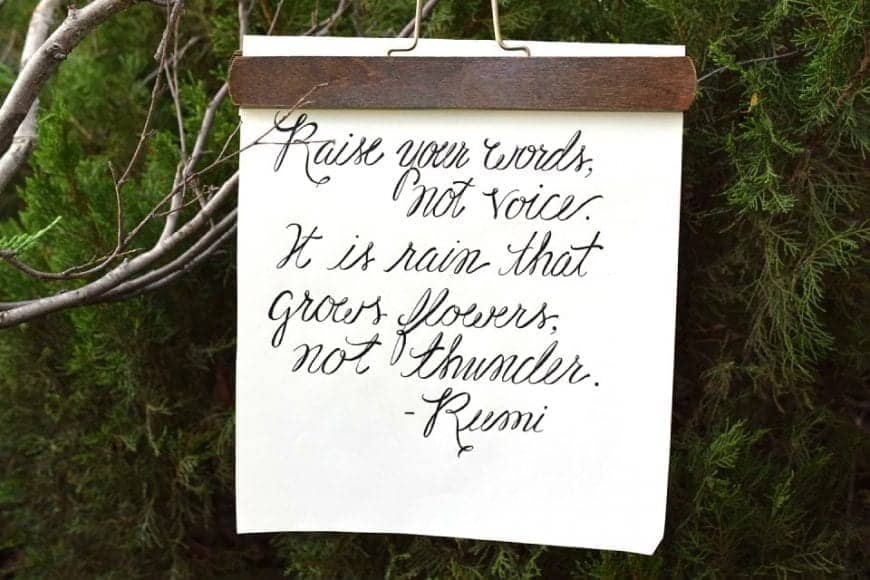Calligraphy has been around since approximately 600 B.C. if you can imagine that, but it’s having a serious revival. Modern-day scribes have repurposed and revitalized a once-formal, borderline stuffy art into one that’s all the rage, and we’re so happy to see it rise from the metaphorical ashes. Besides the fact that hand-lettering is quite lovely to look at, it’s also a hobby that can help you relax, be more expressive and maybe even earn a few extra bucks on the side. The best part about calligraphy is that it’s easy on the wallet. Calligraphy supplies are generally affordable, whether you’re a lettering learner or a calligraphy connoisseur.
If you fall somewhere in the middle, you might occasionally hit a wall in the learning department. You probably already have a handle on upstrokes, downstrokes, kerning and flourishes, but aren’t quite sure where to go from there. Where classic calligraphy was big on predetermined rules and repetition, modern calligraphy is all about expression and style, so you can never really be “done” learning. In lettering, learning is all about exploration, practice, and creativity! Here are some great ideas to help keep you going if you’re feeling stuck in a lettering rut.

- Go Back to “Faux” Calligraphy—If your calligraphy interest started in school with a ballpoint pen, your notebook margins and some creativity, you’re probably already aware of faux calligraphy without even knowing it. This is the art of mimicking hand-lettering with pens and supplies you’re naturally comfortable with, usually before you graduate to fountain pens. Because you’re simply creating outlines of words, faux calligraphy can help you effectively deconstruct your style to identify where you’re falling short. Don’t think of it as retrogression, but instead as an audit to assess where you can improve.
- Learn New Styles—These days, modern calligraphy and hand-lettering are more popular than traditional calligraphy but learning the fundamentals of various styles can be useful to helping you expand your repertoire and better understand the craft. Even though it’s ideal for laying the foundation of calligraphy, many learners don’t start with traditional calligraphy and instead jump straight to contemporary styles. You can learn a lot from going back and learning traditional versions or, alternately, trying your hand at more expressive, modern styles if you’re trained in the ancient art.
- Get Inspiration Wherever You Can—You won’t be a good writer if you aren’t a good reader, you won’t be good at sports if you’re not willing to study the hall-of-famers and you won’t be good at lettering if you’re learning in a vacuum. Calligraphy, like any other art, is equal parts imitation and creation. Beginners often forge their own styles by watching expert letterers, but you should make sure that you’re learning from the experts throughout your lettering journey. You’ll only get so far in the world of calligraphy if you’re not engaged with the calligraphy community, so make sure to follow a few who inspire you on social media.
- Get A Nicer Set of Pens—Have you ever noticed that if you have a new outfit, coffee mug or pair of shoes that it’s somehow more fun to get out of bed and go to the work in the morning? We’re not suggesting that you buy something new every time you’re feeling bored, but the occasional upgrade can do serious wonders for your motivation and inspiration. Picking up a new calligraphy kit or pen set is one of the simplest ways you can reignite your interest in the craft. Anyway, in calligraphy, tools have a lifespan—pens only have so much ink, after all—so think of new supplies as an investment!
- Change Your Posture—It’s such a small and often overlooked thing, but did you know that your posture can actually affect the way you write? Spending some time to master your posture can help you stabilize your body and still your mind so that you can completely focus on the work in front of you. Good posture also helps ensure that you don’t experience any lingering pain or fatigue that could affect the way you hold or grip your pens.
- Try Something New—In any pursuit, the occasional bit of pressure is good for pushing you to the next level. If your calligraphy hobby has never seen the light of day beyond your sketchbook practice notebook, it’s time to give yourself a new purpose—sharing your skill with the world. This could be something as simple as addressing a letter to a friend or hand-lettering a memo at work or something as monumental as offering your services for sale online. You’ll find that when you know you have an audience, you’ll be particularly motivated to push yourself to do better.
- Share Your Progress—Classic and contemporary calligraphy may be polar opposites, but they have one thing in common: They’re both bolstered by extremely supportive communities on social media, blogs, YouTube and even in real-life meetup groups. One of the most important steps of your calligraphic journey is to get feedback as you go. When you’re so deep into something, sometimes it’s hard to see what’s flawed or what’s working particularly well. Upload a few projects online and ask for no-holds-barred feedback to get a sense of what you need to improve upon.
- Experiment with Supplies—Last but not least, it’s important that you challenge yourself and keep things interesting through experimentation. At the end of the day, the pens and paper you choose are a matter of personal preference, but you’ll notice that even the slightest adjustment can change the outcome for better or for worse. Experimenting with utensils—going from fountain pen to brush pen and vice versa, for example—will help you find a good rhythm and help take your hobby to new heights.


The key to any new pursuit is to maintain your enthusiasm and the same goes for calligraphy. Whether you decide to link up with likeminded letterers, invest in a new set of pens or master another element



